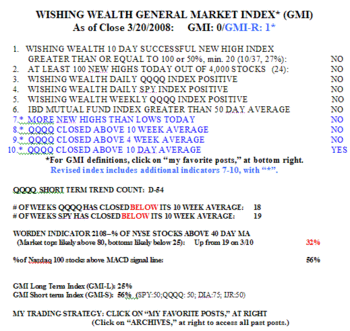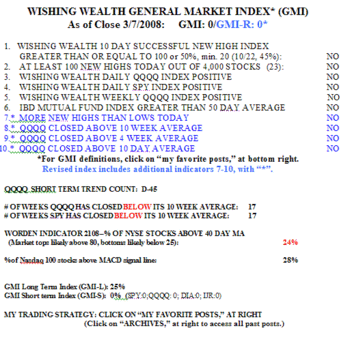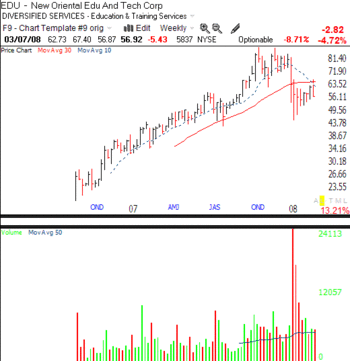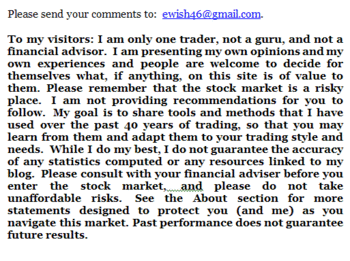The GMI (General Market Index) remains at zero (out of 6) but the GMI-R rose to 4 (of 10). All of the four very sensitive short term indicators I added to form the revised GMI are now positive. Another up day will begin to raise the original GMI. For the first time since February 27, there were more new highs than lows (55 vs. 35) in my universe of 4,000 stocks. 50% of the Nasdaq 100 stocks are now above their 30 day averages. The Worden T2108 indicator is now at 46%, well out of bottoming territory. Market tops usually occur when this indicator is around 80%. Monday was the 55th day of the current QQQQ down-trend, which may be about to end. There were 10 stocks on the IBD100 lists I have monitored the past year that hit a new high on Monday: LKQX, MA, PTNR, KEX, GEF, PCLN, GILD, AXYS, URBN, ISYS. This list may contain one or more of the new market leaders should this rally last.
IBD
GMI: O: GMI-R: 1; Window dressing rally?
The GMI remains at zero (of 6) and the GMI-R is one (of 10). 
There were 24 new highs and 174 new lows on Thursday in my universe of 4,000 stocks. In spite of the fact that Thursday was the 54th day of the current QQQQ short term down-trend (D-54), there are some signs that the market may be strengthening. First, keep in mind that we are near the end of the first quarter when mutual funds are believed to buy strong stocks to appear in their portfolios when their end of quarter reports are released. Since these reports do not show the date of purchase, the fund managers can look especially smart, even though they may have held these winners only for a few days. Second, I remember how bear markets have ended over the past 40 years and that the first stocks that people feel more comfortable buying are the big name large cap stocks. Only after a new bull market is under way and people have some profits, do they feel confident to buy the more speculative stocks. The strength I am finding in the Dow 30 stocks may be reflecting such a bias. The Dow index closed above its 30 and 50 day averages on Thursday on the largest daily volume since its bounce off of the bottom on January 23rd, and a majority of the Dow’s components are now above their 30 day averages. In addition, the QQQQ is only .13 below its 30 day average, which it has closed below all 2008, since January 2nd. Two closes above that level will signal to me a likely change in trend in the Nasdaq 100 index and tech stocks in general. And pessimism is rampant, with the Investor’s Intelligence poll now showing more newsletters bearish than bullish (45% vs. 31%, rounded–source IBD) a very rare occurrence. And the Worden T2108 indicator has rebounded to 32%, up from 19% on March 10. Finally, 56% of the Nasdaq 100 and the S&P 500 stocks have a MACD (12/30/9) that has closed above its signal line, up from below 20% on March 10.
All of these indicators suggest to me that this is not the time for me to take on new short positions. If I were short, I would place close buy stops on my positions to limit losses. Rather, I am prepared to slowly accumulate the ultra long ETF’s on the Dow (DDM), S&P 500 (SSO) or the NASDAQ 100 (QLD) indexes if their key moving averages are broached this week. Nevertheless, I have learned from trading all of these years that it does not pay to try to anticipate changes in trend. It is much safer and more profitable to wait for a confirmation that the up-trend has begun. A GMI reading above 3 would encourage me to go long. A failure to penetrate and hold the key levels I have noted would be a sign for me to move into the comparable ultra short ETFs (DXD, SDS and QID).
GMI: 0; GMI-R: 0; Short or in cash; EDU as a model short
The GMI and GMI-R are each registering zero. The markets are in solid down-trends, with the SPY and QQQQ closing below their 10 week averages for 17 weeks.  There were only 23 new highs and 504 new lows in my universe of 4,000 stocks on Friday . The Worden T2108 indicator is now at 24%, still above the extreme level at which the market tends to bottom. At the the January bottom, it registered 18%. At the bottom in 1987, it registered an amazing less than 1%. Most recent bottoms/bounces occur in the area around 14%.
There were only 23 new highs and 504 new lows in my universe of 4,000 stocks on Friday . The Worden T2108 indicator is now at 24%, still above the extreme level at which the market tends to bottom. At the the January bottom, it registered 18%. At the bottom in 1987, it registered an amazing less than 1%. Most recent bottoms/bounces occur in the area around 14%.
Only 19% of the Nasdaq 100 stocks closed above their 30 day averages and only 28% had their MACD close above its signal line. Since the current QQQQ short term down-trend began on January 2nd, that index has declined 16.6%, and 80% of its components stocks have declined–30% have fallen 20% or more. In the same period, 76% of the the stocks I monitor from the IBD100 lists the past year have also declined. The lesson to be learned is that one should not hold stocks in a general market down-trend. Why not be in cash or short in a market decline?
So, since I won’t buy rocket stocks (I found 55) in a down-trend (stocks just rarely keep hitting new highs), I used TC2007 to look for some submarine stocks and found over 500. All of these stocks are in confirmed down-trends. 
The following stock, EDU, has a real promising chart pattern, and is selling at a price-to-sales ratio of over 13! This weekly chart (click on to enlarge) shows that EDU tripled, formed a top and then broke down on huge volume (when the company talked of tougher earnings comparisons in future quarters). After breaking below its 30 week average (red line), EDU rebounded and failed last week to hold that line. Furthermore, its 10 week average (blue dotted line) is now below its 30 week average. This is the type of stock I might short by buying a put in my IRA. I would close the trade with a loss if the stock trades again above last week’s high of 67.40. There are so many submarines with patterns like this. In the current market environment, the odds of success favor going short on a submarine like this rather than betting on the rare rocket on the long side. Alternatively, I could wait safely on the sideline, in cash.

